Kiaan’s story, by his mother
“I wish people understood that rare doesn’t mean less real“

How did you feel when your child received a diagnosis of GM1?
When we walked into the neurologist’s office, we were expecting more inconclusive results — just like all the previous appointments. We left the room without fully grasping what GM1 gangliosidosis meant.
We read more on the way home and the reality hit us: our vibrant and joyful son would one day lose his ability to walk, talk, eat, and understand the world around him. His lifespan would likely be drastically shortened — mid-childhood to early adulthood.
It’s impossible to describe how it feels to look at your child and know what lies ahead. The future we once planned and looked forward to became a timeline we feared.
Our world changed in an instant.
How has GM1 gangliosidosis affected your child?
GM1 has affected so many parts of Kiaan’s life. He struggles with climbing stairs and can’t jump, which makes it hard to keep up with friends at the playground. It breaks our hearts when he says, “I am alone,” watching others race ahead.

Kiaan is incredibly funny and witty, but his speech articulation makes it hard for strangers to understand him. His fine motor challenges mean he avoids drawing and coloring — things most kids his age love.
Since gene therapy, he’s had to take several medications every day. It’s been hard on him, and sometimes, when he struggles, he says, “It’s all my fault.” No child should ever feel that way. Still, through it all, he brings joy, light, and laughter into our lives — just by being who he is.
How does GM1 impact your family?
GM1 has completely reshaped our world as a family. The future we once imagined is now filled with uncertainty and fear — and yet, also deep love and fierce purpose. Every routine and decision now centers around Kiaan’s care and comfort. Watching him struggle with things that should come easily — running, jumping, speaking clearly — is heartbreaking. It’s hard to explain what it feels like to grieve a future that hasn’t yet arrived.
Kiaan’s 7-year-old sister has had to grow up quickly. She’s learning to understand his diagnosis in ways no child her age should have to. She’s made quiet sacrifices — giving up time, space, and sometimes attention — all with the tenderness of a big sister who just wants her brother to feel safe and loved.
And yet, something beautiful has emerged. Our little family of four has grown closer than ever. We’ve felt the power of community — with friends and extended family surrounding us in unwavering love. Their support has helped carry us through the hardest days.

We’ve learned to slow down, to celebrate small victories, and to blanket Kiaan in love — always.
What is the hardest part of being a GM1 caregiver?
The hardest part of being a GM1 caregiver is knowing what’s ahead — and still trying to stay fully present for today. It means watching your child lose abilities, managing daily medical needs, and carrying the emotional weight of it all while making life feel normal. It’s loving deeply, even when your heart is breaking..
What do you wish people understood more about rare diseases?
I wish people understood that rare doesn’t mean less real — or less painful. When Kiaan was diagnosed, even the doctor had never seen a patient with GM1 before. We were their first. That moment alone speaks volumes about how isolating rare diseases can be.
There are so many unknowns. We don’t know how quickly or slowly the disease will progress — only that it will. And still, we have to make decisions, hold onto hope, and show up for our child every single day.
Living with GM1 means carrying love and fear at once, while trying to give your child the fullest life possible in the face of heartbreaking uncertainty.
If we could tell people just one thing about GM1 gangliosidosis, what would it be?
GM1 gangliosidosis a rare disease that takes everything from a child — their ability to move, speak, eat, and connect. But behind GM1 is a child full of life and love — and they deserve to be seen, supported, and fought for.
Your support could be the reason a cure becomes possible.
Why should people support the Cure GM1 Foundation and rare disease research?
Because children like Kiaan are running out of time — and they deserve a future. GM1 gangliosidosis is a rare, fatal genetic disease that most people — even doctors — have never heard of. There’s no cure yet, and very little funding, simply because it’s rare.
The Cure GM1 Foundation is working to advance research, push for treatments, and support families like ours in every possible way. They’ve given us something just as vital: a community. A place to be seen, heard, and held by others walking the same difficult path.
Is there anything else you would like to add to your story?
If there’s one thing we’ve learned through this journey, it’s that love truly is stronger than fear. We never imagined our story would include a rare disease like GM1, but here we are — holding tight to every smile, every word, every step Kiaan takes.


